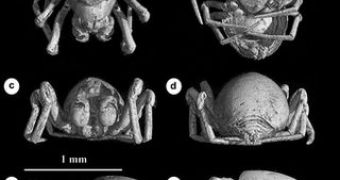Sophisticated techniques are needed to investigate living tiny spiders. But what about a 50-million-year-old one? Such a fossil has been "revived" in an amazing 3D imagery.
Dr David Penney from The University of Manchester and researchers from Ghent University in Belgium described the use of 'Very High Resolution X-Ray Computed Tomography' (VHR-CT) for a 'digitally dissect' of extremely small fossils, showing off their internal structure, in a study published in the latest issue of the Zootaxa journal.
The male spider investigated with the novel technique is a new species called Cenotextricella simoni, around 53-million years old, which was discovered fossilized in amber coming from Paris Basin (France). The VHR-CT had never been employed before to digitally dissect an amber fossil and could boost the research of fossils preserved in amber. The technique was initially aimed for medical use, easing diagnosis.
"This technique essentially generates full 3D reconstructions of minute fossils and permits digital dissection of the specimen to reveal the preservation of internal organs. Up until recently the only place to do such scans was at The University of Texas, although they never achieved results like these. My colleagues in the department of Subatomic and Radiation Physics at Ghent University in Belgium have significantly increased the resolution of the technology, bringing some quite amazing results.", said Penney, a specialist in spiders trapped and preserved in amber tens of millions of years ago.
"This is definitely the way forward for the study of amber fossils. Amber provides a unique window into past forest ecosystems. It retains an incredible amount of information, not just about the spiders themselves, but also about the environment in which they lived." he added.
Recently, a species of Mexican spider, 20 million years old, was found and baptized after Dr Penney, "Episinus penneyi".

 14 DAY TRIAL //
14 DAY TRIAL //